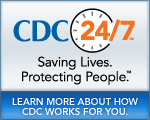MMWR
Morbidity and Mortality Weekly Report
MMWR News Synopsis for August 2, 2007
- Wildfire-Related Deaths a€” Texas, March 12a€“20, 2006
- Breastfeeding Trends and Updated National Health Objectives for Exclusive Breastfeeding a€” United States, 2000a€“2004
- Youth Exposure to Alcohol Advertising in Magazines a€” United States, 2001a€“2005
There will be no MMWR telebriefing scheduled for:
August 2, 2007
Wildfire-Related Deaths a€” Texas, March 12a€“20, 2006
PRESS CONTACT: CDC Division of Media Relations
(404) 639-3286
David F. Zane, M.S.
Texas Department of State Health Services
(512) 458-7111, ext 6422
Wildfires pose dangers to the public′s health. All wildfire-related deaths are potentially preventable. Public education about the hazards of wildfires and proven effective prevention methods that homeowners and responders can take to protect home and property should always be emphasized. Preparedness and disaster planning are essential to reducing the dangers and saving lives. In March 2006, wildfires burned approximately 1 million acres in the panhandle region of Texas, advancing 45 miles in 9 hours, with dense smoke and flames up to 11 feet. These wildfires were the largest wildfires and tragically resulted in the largest number of human deaths related to wildland fires in Texas′ history. Sadly, these wildfires resulted in the largest loss of human life due to wildfires in the United States in 2006 and the largest number of civilian deaths due to wildfires in the country since 2003. The purpose of the investigation was to describe the circumstances of the deaths related to the wildfires in Texas in 2006 and to recommend prevention measures. These measures include the importance of adhering to warning and evacuation orders, not driving through smoke on roadways, having an exit strategy and avoiding the path of the wildfire. Prevention measures also exist for individuals caught at home, caught out in the open, and those in vehicles.
Breastfeeding Trends and Updated National Health Objectives for Exclusive Breastfeeding a€” United States, 2000a€“2004
PRESS CONTACT: CDC Division of Media Relations
(404) 639-3286
- Press Release
More Women Choosing to Breastfeed, but Rates of Exclusive Breastfeeding Fall Short of National Objectives
Identification and implementation of successful programs that increase rates of breastfeeding, particularly exclusive breastfeeding among all sociodemographic groups, are needed to achieve all targets for breastfeeding rates. Rates of breastfeeding initiation and duration are increasing among infants; however, disparities exist for infants who are exclusively breastfed, according to a new CDC study. Data collected from the National Immunization Survey (NIS) showed that breastfeeding initiation and duration increased consistently among infants born from 2000 to 2004. Among infants born in 2004, the rate for breastfeeding initiation was 73.8 percent increasing from 70.9 percent among infants born in 2000. In contrast, rates of exclusive breastfeeding were far below the target rates. Among infants born in 2004 the rate of exclusive breastfeeding through age 3 months was 30.5 percent (target rate 60 percent) and through age 6 months was 11.3 percent (target rate 25 percent). The study also found disparities in exclusive breastfeeding by sociodemographic populations. Studies show that breastfeeding, especially exclusive breastfeeding, provides many health benefits for both mothers and infants.
Youth Exposure to Alcohol Advertising in Magazines a€” United States, 2001a€“2005
PRESS CONTACT:(Primary Contact) David H. Jernigan, Ph.D.
Executive Director
Center on Alcohol Marketing and Youth
Georgetown University
(202) 687-0613
CDC Division of Media Relations
(404) 639-3286
Most youth exposure to alcohol advertising still comes from magazines with a youth-oriented readership (i.e., where greater than 15 percent of readers are aged 12-20 years). Eliminating alcohol advertising in media with greater than 15% youth audiences, as recommended by the Institute of Medicine, would substantially reduce youth exposure to alcohol marketing and could reduce future youth drinking. Ongoing, independent monitoring of alcohol marketing to youth should also be continued, as recommended by the Surgeon Generala€?s recent report. From 2001 to 2005, alcohol advertising remained common in magazines with a youth-oriented readership (i.e., a readership of greater than 15 percent youth aged 12a€“20 years), but decreased substantially in magazines with greater than 30 percent youth readership, according to a new study. The study, conducted by the Center on Alcohol Marketing and Youth at Georgetown University, evaluated the placement of alcohol advertisements in national magazines. The proportion of alcohol advertisements in magazines with greater than 30 percent youth readership decreased from 10.6 percent in 2001 to 0.3 percent in 2005, and the proportion of all youth exposure to alcohol marketing resulting from this advertising decreased from 20.8 to 0.9 percent. However, almost 45 percent of alcohol advertisements were still placed in magazines with a youth-oriented readership in 2005, accounting for more than 80 percent of all youth exposure to alcohol advertising in magazines. By beverage type, liquor accounted for most youth exposure to alcohol advertising in national magazines.
####
- Historical Document: August 2, 2007
- Content source: Office of Enterprise Communication
- Notice: Links to non-governmental sites do not necessarily represent the views of the CDC.
View Press Releases in
Get e-mail updates
To receive e-mail updates about this page, enter your
e-mail address:
Contact Us:
- Centers for Disease Control and Prevention
1600 Clifton Rd
Atlanta, GA 30333 - 800-CDC-INFO
(800-232-4636)
TTY: (888) 232-6348 - Contact CDC-INFO


